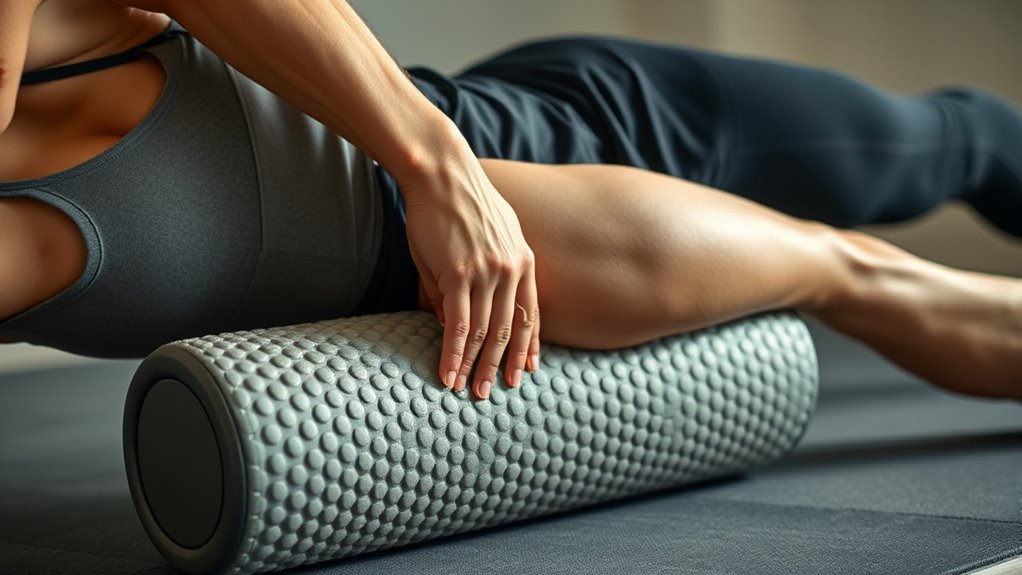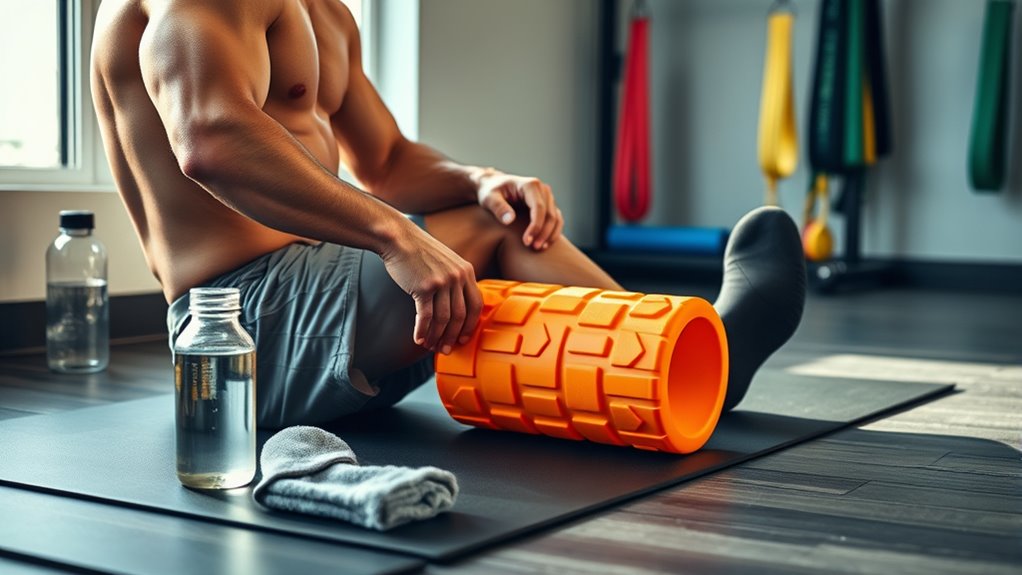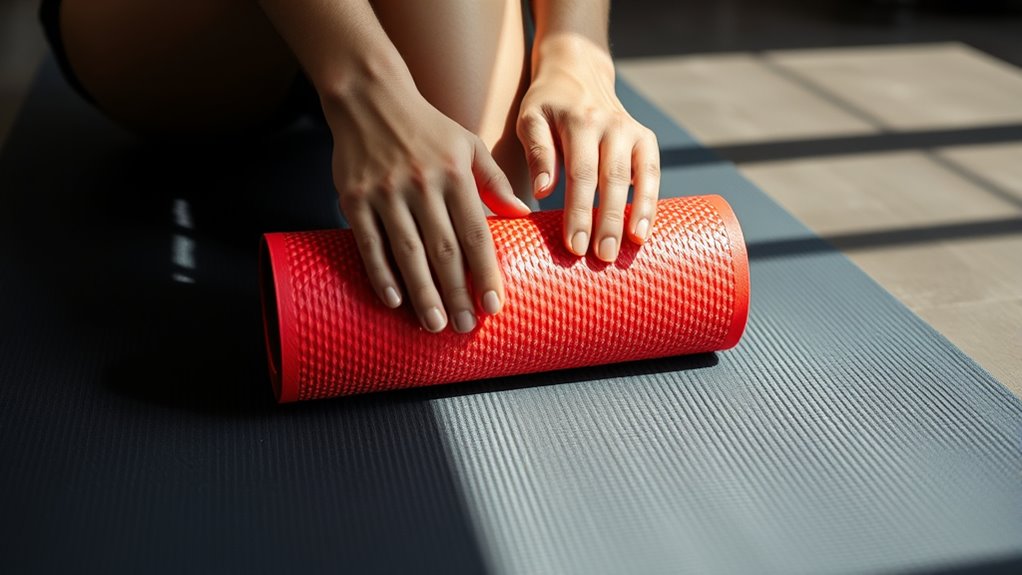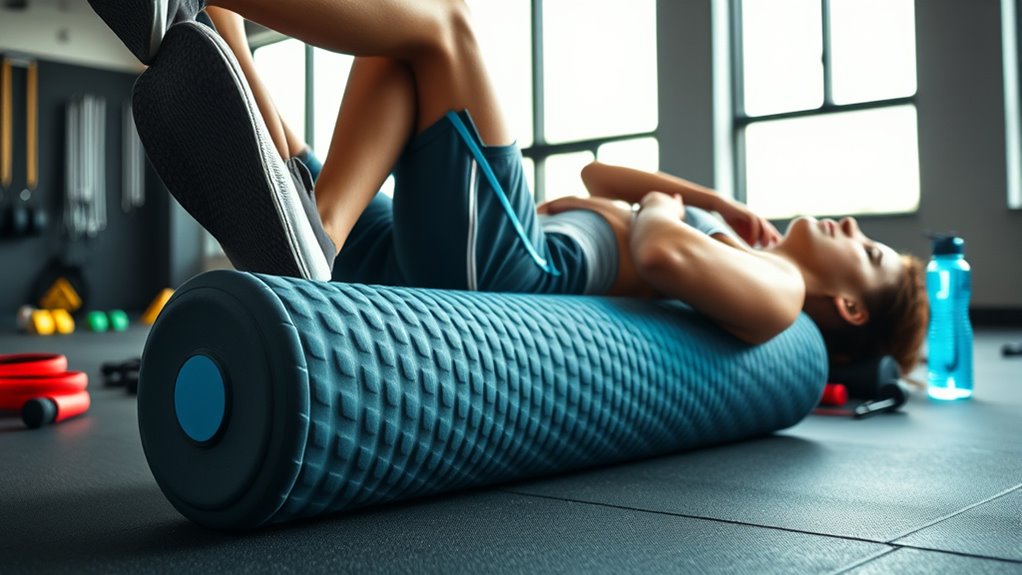To optimize your recovery with foam rolling, focus on selecting the right roller based on comfort and muscle needs, and prepare by hydrating and warming up. Use steady pressure and target tight areas, avoiding pain, and incorporate mindful breathing to relax muscles. Developing a consistent routine that combines foam rolling with proper hydration, stretching, and nutrition enhances results. Keep track of progress to adjust your protocol, and if you continue exploring, you’ll discover even more effective strategies.
Key Takeaways
- Select a foam roller suited to your muscle sensitivity and recovery needs, considering material, density, and surface texture.
- Apply steady, moderate pressure with slow rolling movements, pausing on tender spots to release fascia and improve flexibility.
- Prepare for sessions with deep breathing, hydration, and gentle warm-up exercises to enhance muscle relaxation and circulation.
- Incorporate foam rolling into a consistent routine, aligned with proper nutrition and active recovery strategies for optimal results.
- Monitor progress regularly, adjusting pressure and duration to prevent injury and maximize muscle recovery benefits.
Understanding the Benefits of Foam Rolling

Understanding the benefits of foam rolling can considerably enhance your recovery and overall performance. When you incorporate foam rolling into your routine, you improve muscle flexibility by releasing tightness and reducing soreness. This process helps elongate muscles and fascia, making movement easier and more efficient. Additionally, foam rolling promotes circulatory improvement by increasing blood flow to targeted areas. Better circulation delivers essential nutrients and oxygen, speeding up recovery and reducing fatigue. As you roll, you break down adhesions and knots that limit your mobility, which can lead to a greater range of motion. These benefits work together to optimize your physical health, helping you perform better in workouts and recover faster afterward. Incorporating automation technologies into your recovery routine can further streamline your process and maximize benefits. Using targeted tuning techniques can also help customize your recovery for specific muscle groups. Moreover, understanding muscle fascia and how foam rolling affects it can deepen your effectiveness with this technique. Recognizing the importance of AI in healthcare can also inform how you approach personalized recovery strategies.
Selecting the Right Foam Roller for Your Needs

Choosing the right foam roller is essential to maximize your benefits and guarantee comfort during use. Consider material selection carefully; high-density foam offers durability and firm support, ideal for deep tissue work, while softer options provide gentler pressure for beginners or sensitive areas. Portability considerations matter if you plan to roll on the go; lightweight, compact rollers are easy to carry in a gym bag or suitcase. Also, think about the surface texture—smooth surfaces are versatile, whereas textured rollers can target specific muscles more effectively. Your choice should align with your fitness level, the areas you want to target, and whether you need a portable solution. Additionally, understanding the different foam roller types can help you select the most suitable one for your recovery needs. For optimal results, consider how material selection impacts durability and comfort during your sessions. Incorporating knowledge about recovery tools like foam rollers can significantly enhance your healing process and reduce discomfort. Furthermore, the effectiveness of hydrocolloid patches demonstrates how proper recovery tools can accelerate healing and reduce discomfort, emphasizing the importance of selecting the right equipment. Selecting the appropriate foam roller ensures you get the most out of your recovery routine without sacrificing comfort or convenience.
Preparing for an Effective Foam Rolling Session

Before you start foam rolling, it’s important to prepare your body to maximize effectiveness and reduce injury risk. Begin with deep, steady breathing techniques to relax muscles and improve circulation. Proper breathing can help you achieve better muscle relaxation during the session. Hydration tips also matter—drink water beforehand to keep tissues supple and aid recovery. Warm up lightly with dynamic stretches or gentle movement to increase blood flow. Use the table below to guide your prep:
| Step | Tips |
|---|---|
| Breathing techniques | Inhale deeply through your nose, exhale slowly through your mouth |
| Hydration tips | Drink a glass of water 15-30 minutes before rolling |
| Warm-up | Do light activity like walking or arm circles |
| Mindful mindset | Focus on relaxing and listening to your body |
Additionally, ensuring proper contrast ratio can help you better gauge muscle tension and relaxation during your session. Incorporating proper muscle activation techniques can further enhance your foam rolling effectiveness. Engaging in muscle awareness exercises prior to rolling can improve your ability to target specific areas effectively.
Proper Techniques for Targeted Muscle Release

To effectively target specific muscles during foam rolling, you need to use proper techniques that maximize pressure and control. Focus on applying steady, moderate pressure directly on the muscle, avoiding excessive weight that could cause discomfort. Roll slowly over the area, pausing on spots of high muscle tension or tender points to encourage fascia release. Maintain consistent contact with the foam roller, adjusting your body position to target different angles and depths. Use your arms or legs to control the pressure, ensuring you stay within a comfortable range while still working effectively. Proper technique enhances fascia release and releases muscle tension, helping improve flexibility and reduce soreness. Incorporating appropriate tools can also aid in achieving targeted muscle release for more effective results. Being mindful of fascial health can contribute to more effective recovery and injury prevention. Additionally, understanding the types of foam rollers available can help you select the most suitable tool for your needs. Selecting the right foam roller density ensures optimal pressure for different muscle groups and sensitivity levels. Keep movements deliberate, controlled, and focused on the targeted muscle for ideal results.
Common Mistakes to Avoid During Foam Rolling

One common mistake during foam rolling is applying too much pressure too quickly. This can lead to overdoing it, causing unnecessary discomfort or even injury. Remember, foam rolling shouldn’t hurt; if you ignore pain, you risk aggravating muscles instead of relaxing them. Be gentle at first, gradually increasing pressure as your body adapts. Additionally, understanding muscle recovery can help you optimize your foam rolling technique for better results. Being aware of proper projector bulb maintenance can also prevent issues that hinder your overall experience. Recognizing the importance of risk management in your routine can further enhance your safety and effectiveness during foam rolling. Incorporating proper techniques and timing can maximize benefits and reduce the likelihood of setbacks.
Developing a Consistent Foam Rolling Routine

Establishing a consistent foam rolling routine is essential for maximizing its benefits and ensuring steady progress. To stay on track, incorporate mindful breathing to enhance relaxation and focus during each session. Develop a schedule that fits your lifestyle, whether daily or every other day, to build a habit. Remember to follow hydration strategies before and after rolling to keep tissues supple and aid recovery. Consider these tips to stay consistent: proper size and comfort considerations, set specific times each day for foam rolling, use mindfulness breathing to deepen relaxation, stay hydrated to support muscle recovery, and be mindful of lifestyle integration to maintain long-term adherence. Additionally, understanding the importance of AI advancements in health tech can inspire innovative approaches to recovery routines. Incorporating mindfulness techniques into your routine can also enhance the overall benefits and promote mental well-being.
Integrating Foam Rolling With Other Recovery Strategies

Incorporating foam rolling alongside other recovery strategies enhances overall muscle health and performance. To maximize benefits, coordinate your foam rolling with proper nutrition timing—consume carbs and protein post-rolling to support muscle repair. Hydration strategies are equally important; drinking water before and after foam rolling helps flush out toxins and keeps tissues supple. Combining these methods promotes better circulation, reduces soreness, and speeds recovery. You might also incorporate gentle stretching or active recovery alongside foam rolling to enhance flexibility and blood flow. By integrating these strategies, you create a holistic approach that supports muscle resilience and minimizes injury risk. Remember, consistency and timing are key—align your foam rolling sessions with proper nutrition and hydration to optimize recovery and maintain peak performance.
Monitoring Progress and Adjusting Your Protocol

Tracking your progress is essential to guarantee your foam rolling routine remains effective and aligned with your goals. By monitoring effectiveness, you can identify what’s working and where adjustments are needed. To do this, pay attention to how your muscles feel before and after sessions, noting improvements or lingering tightness. Regularly reassess your protocol to ensure you’re adjusting intensity appropriately—neither overdoing it nor under-stimulating your tissues. Consider these key tips:
- Keep a recovery journal to record sensations and improvements
- Adjust pressure or duration based on your feedback
- Schedule periodic check-ins to evaluate progress and refine your routine
This approach helps you stay on track, optimize results, and prevent injury, making your foam rolling more targeted and effective over time.
Frequently Asked Questions
How Often Should I Replace My Foam Roller?
You should replace your foam roller when you notice signs of wear and tear, like cracks or excessive softness, which indicate the end of its foam roller lifespan. Regularly check for replacement indicators such as flattened areas or loss of firmness. Generally, if you use it frequently, consider replacing it every 6 to 12 months to ensure effective and safe foam rolling sessions. Proper maintenance helps you get the most out of your roller.
Can Foam Rolling Help With Injury Prevention?
Imagine you’re an athlete who incorporates foam rolling into your routine. Regular foam rolling can help with injury prevention by enhancing muscle recovery and supporting joint health. It reduces muscle tightness, improves flexibility, and decreases the risk of strains. By maintaining healthy muscles and joints, you lower injury chances, making foam rolling a valuable part of your preventive strategy. Consistent use helps keep your body resilient and ready for activity.
Is Foam Rolling Suitable for All Age Groups?
You might wonder if foam rolling suits everyone. While it’s generally beneficial, age appropriateness varies. Older adults can use foam rolling with gentle pressure, but they should consider accessibility considerations like softer rollers or professional guidance. Kids and teens should consult a healthcare provider before starting. Always listen to your body, start slow, and adapt techniques to guarantee safe and effective use across different age groups.
What Are the Signs of Overdoing Foam Rolling?
If you overdo foam rolling, you might notice increased muscle soreness and skin irritation. You could feel tender or bruised in the treated areas, and your muscles might become more tender rather than relief. It’s important to listen to your body, avoid rolling over inflamed or damaged skin, and limit sessions to prevent these signs. Proper technique and moderation help guarantee foam rolling remains a safe, effective part of your recovery.
Can Foam Rolling Improve Flexibility Beyond Stretching?
You might wonder if foam rolling can enhance flexibility more than stretching. It can, by promoting muscle relaxation and breaking down adhesions, which stretching alone might not fully achieve. Foam rolling helps release tension, improve blood flow, and support posture correction, all of which contribute to greater flexibility. Incorporating foam rolling into your routine can lead to deeper muscle release, making your stretching more effective and improving overall mobility.
Conclusion
By integrating foam rolling into your recovery routine, you’re nurturing your muscles like a gardener tending delicate blooms. Consistency and proper technique will help you discover better mobility and reduce soreness. Think of foam rolling as the gentle rain that nourishes your body’s resilience, allowing you to perform at your best. Stick with it, stay mindful, and watch your progress flourish—because with patience, your recovery becomes as natural as the sunrise.










